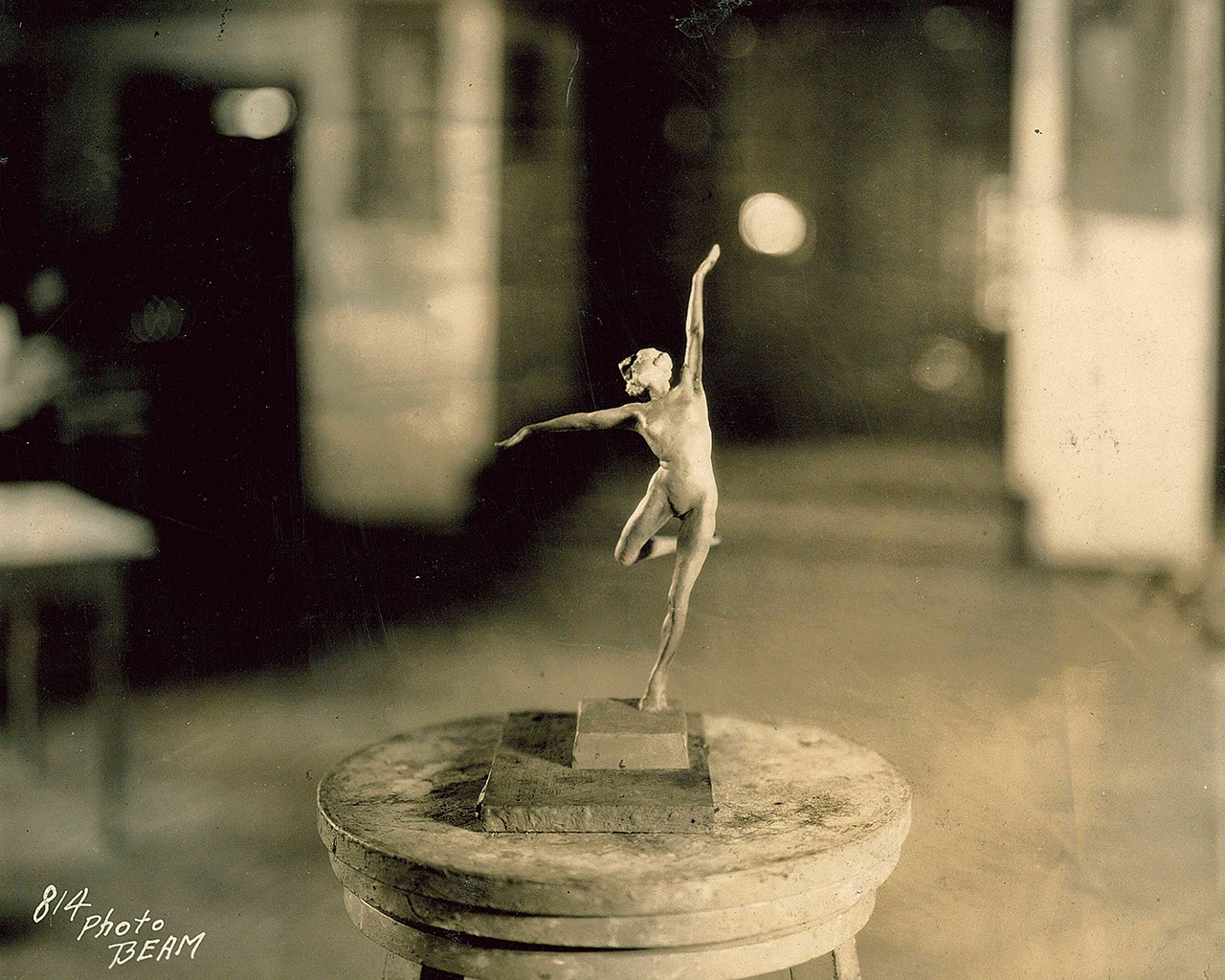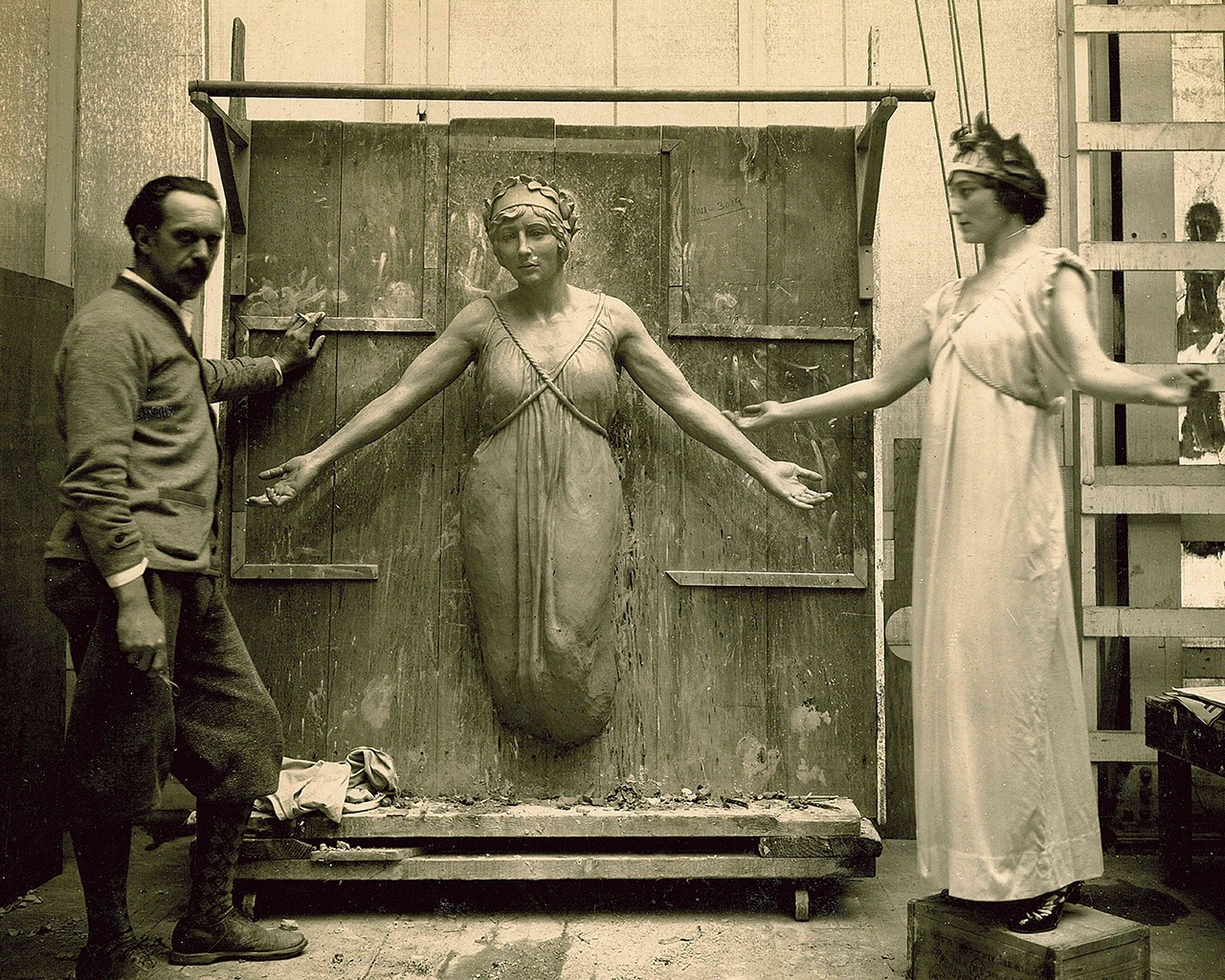2002 North Main Street
Santa Ana, California 92706
TEL: 714.567.3600
Bowers Museum’s South Coast Plaza Display
 |
| Bowers Museum's display at South Coast Plaza's Jewel Court, image from Bowers' Exhibit Design Department |
Trip to the Mall
The Bowers Museum is very excited to be collaborating with South Coast Plaza on a temporary display in their Jewel Court that both promotes our upcoming Fall/Winter exhibitions and includes five cases of highlights from the Bowers’ permanent collections. These permanent collection highlights in particular speak to the wonderfully diverse nature of what is held in our museum by representing arts from all around the world. This post takes a close look at the objects in these five cases, linking to even more specific reading on the Bowers Blog for those that are interested.

 |
| Photograph of Ella Buchanan's (American, 1867-1951) untitled sculpture (76.30.17) at Nelli Art Bronze Works. |
 |
| Guido Nelli in his studio with a model and partially completed sculpture, c. 1930 |
California Sculptures Cast at Nelli Art Bronze Works
The first of these cases explores the works of Guido Nelli (Italian-born American, 1881-1952), who established himself as the only art bronze works in Los Angeles for a limited period in the late 1920s and early 1930s. Nelli had earned a reputation as one of Europe’s greatest sculptors by working for the last Tsar of the Russian Empire. During the Russian Revolution of 1917, Nelli had to flee for his life. After a few nomadic years, he settled in Los Angles and opened the California Art Bronze Foundry in 1927 (later called Nelli Art Bronze Works). As the only shop in town for those interested in creating sculptural bronze works, Nelli worked directly with a great many artists like Charles Russell and his cowboy bronzes, and with George Stanley and the Academy of Motion Picture Arts and Sciences in creating the very first Oscars. Nelli was featured on the Bowers Blog in a post primarily about the creation of this early Academy Award. This object is included in the South Coast Plaza display alongside a group of female figures by various artists.

 |
| Bowers Museum's Satsuma display at South Coast Plaza's Jewel Court |
Japanese Satsuma Ware
The second case looks at a selection of Japanese art from a period of great change in the country’s history. After the island nation was forcibly opened to European trade in 1853, the country began very quickly changing its domestic and foreign policies to support the production of art exports. This happened to coincide with a new style of overglaze painting being incorporated by artists into the stoneware ceramics that the Satsuma province—today western Kagoshima Prefecture on the island of Kyūshū—had produced for hundreds of years. As Japan’s Meiji government looked to travel their art across the world to show it at trade fairs and international expositions, they selected Satsuma ware to represent the country and appeal to foreign audiences. The result is the vibrant selection of works on display at South Coast Plaza, all of which are decorated with detailed scenes from Japanese history, folklore, and myth. A subset of the 70 Satsuma in the Bowers permanent collection was the subject of a Bowers Blog post from last year.

 |
|
| Wig, mid to late 20th century Unrecorded artist; Highland area, Papua New Guinea, Melanesia Human hair, plant fiber, and cassowary feathers 2017.10.89 Anonymous Gift |
Headdress, mid to late 20th century Unrecorded artist; Southern Highlands Province, Papua New Guinea, Melanesia Cassowary feathers and plant fiber 2017.10.91 Anonymous Gift |
New Guinea Highlands Headdresses
The central case in the display is populated with several objects that have, for the most part, been exhibited in Bowers’ Spirits and Headhunters: Art of the Pacific Islands at one time or another. In Papua New Guinea, as is the case in most cultures, how one dresses and accessorizes says a lot about their status. The wigs and headdresses in this case would only be worn on special occasions such as the popular Sing-Sing Festival in the New Guinea Highlands, feasts, weddings, initiation ceremonies, and more. At these events, individuals wear their finest ensembles, covering their bodies with pigments and donning accessories made with treasured feathers and shells that have been passed down for generations. Several Highlands peoples such as the Huli and Enga wear human hair wigs topped with feathers from parrots, cassowaries, and birds of paradise. Just one of these objects has previously been published here in a post on plumed headdresses.

 |
| Bowers Museum's Papuan currency display at South Coast Plaza's Jewel Court, image from Bowers' Exhibit Design Department |
New Guinea Shell Currency
Beautiful in their minimalism, the fourth case in the display is a selection of shell currency rings that were first featured on the Bowers Blog when they were donated to the museum. Wamayuwa and weingga, the vernacular names for these pieces, were carved from the largest clam shells in the world by the Boiken people of New Guinea. Raw shell was traded from the coast to others living further inland. After being cut to shape with the friction of wetted cords and hollowed out again using the friction of pump or bow drills, they were polished and often decorated with plant fiber wraps. Just as is the case with the Papuan headdresses discussed in this post, shell rings were used—in this case exchanged—on a few occasions including feasts and weddings.

 |
| Pair of Women’s Shoes, Qing dynasty (1644-1911) Unrecorded artist; China Silk and paper 38045.3-.4 Gift of Grace M. Rowley |
Imperial Chinese Women’s Wear
Imperial dress and accessories of the Qing dynasty drew inspiration from the golden eras of China’s history. Elaborate bridal headdresses with adornments that bounced in synchronized movement with their wearer were derived from those worn by the upper classes of the Manchu court. The petite shoes in this case were worn by adult women whose feet had been bound since childhood—a practice that was popularized in the Tang dynasty and outlawed soon after the emperor was deposed in 1912.

Be sure not to miss the temporary display at South Coast Plaza before it closes on August 28!
Text and images may be under copyright. Please contact Collection Department for permission to use. Information subject to change upon further research.

Comments